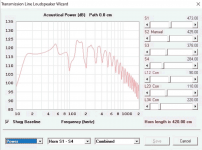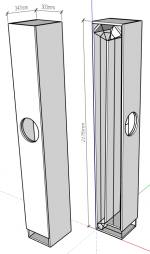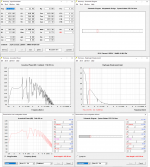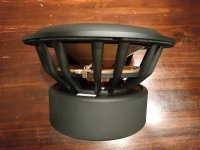Hey Guys,
I'm planning to build my first sub and it will be TL of around 4m length. 😀
My goal is to add the really low frequencies to my audio system: like down to around 15 Hz. I'm not looking for extreme SPL (I have neighbors), but quality sound.
I have a corner in my room to fit a tower shape of around 30 cm width and 30 cm depth, 240 cm tall. Because of the width, a 10" will be the max size.
Within the 240 cm I can easily make a very long TL with just 1 fold.
First try in Hornresp with a Seas 10" on 125 Watts:
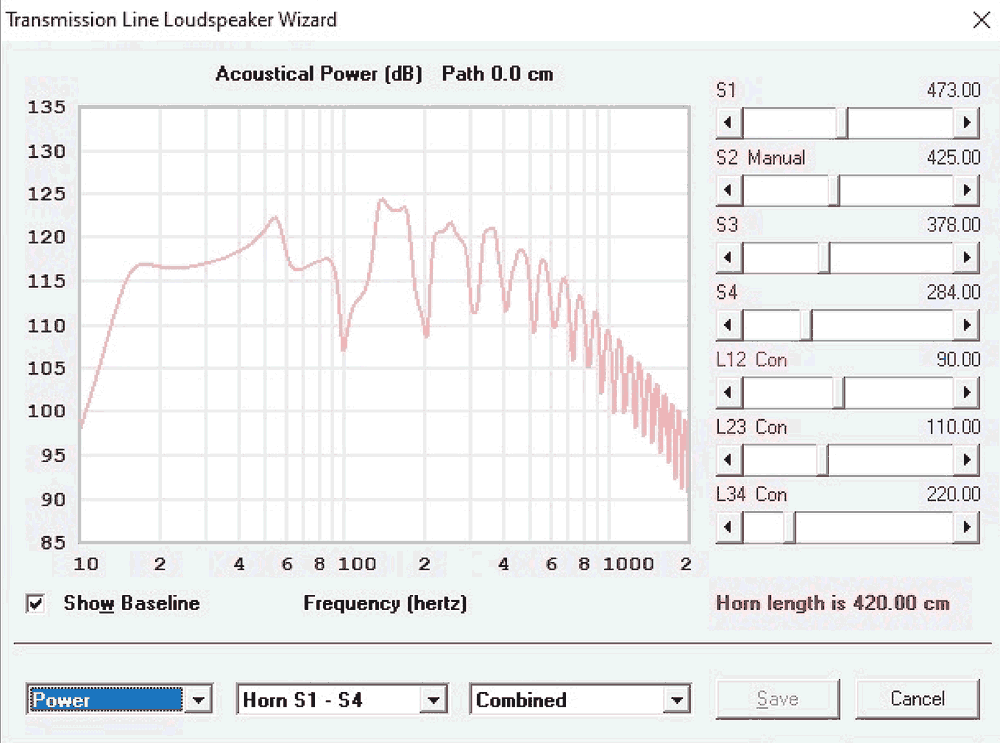
First question is: which driver should I take?
I think I have 2 reasonable options I can afford:
SEAS XM001-04_L26ROY for E 250,=
Dayton Audio UM10-22 for E 230,=
What do guys think of these? Any experiences?
I think about a Crown XLS 1002 to amp it. Enough power (1100 Watt bridged on 4 Ohm) and a very usefull adjustable lowpass filter. So I won't need to build a passive crossover in my sub.
I'm planning to build my first sub and it will be TL of around 4m length. 😀
My goal is to add the really low frequencies to my audio system: like down to around 15 Hz. I'm not looking for extreme SPL (I have neighbors), but quality sound.
I have a corner in my room to fit a tower shape of around 30 cm width and 30 cm depth, 240 cm tall. Because of the width, a 10" will be the max size.
Within the 240 cm I can easily make a very long TL with just 1 fold.
First try in Hornresp with a Seas 10" on 125 Watts:
First question is: which driver should I take?
I think I have 2 reasonable options I can afford:
SEAS XM001-04_L26ROY for E 250,=
Dayton Audio UM10-22 for E 230,=
What do guys think of these? Any experiences?
I think about a Crown XLS 1002 to amp it. Enough power (1100 Watt bridged on 4 Ohm) and a very usefull adjustable lowpass filter. So I won't need to build a passive crossover in my sub.
Attachments
Last edited:
Greets!
In a corner = ~344/8/4 = 10.75 Hz, though will be lower due to pipe end correction making it acoustically longer.
In theory we want a driver Fs = whatever low corner frequency you want and how much boundary gain you actually have, but factoring in neighbors I normally recommend an Fs that's ~ the mean between 15 Hz and the XO point, though all things considered I'd remain true to my Avatar's implication 😉 based on published specs and use the Seas with its higher efficiency.
GM
In a corner = ~344/8/4 = 10.75 Hz, though will be lower due to pipe end correction making it acoustically longer.
In theory we want a driver Fs = whatever low corner frequency you want and how much boundary gain you actually have, but factoring in neighbors I normally recommend an Fs that's ~ the mean between 15 Hz and the XO point, though all things considered I'd remain true to my Avatar's implication 😉 based on published specs and use the Seas with its higher efficiency.
GM
Thanx GM. Interesting you judge based on efficiency. I never looked at that before. Can you explain the advantage of high efficiency? Is it more than just SPL for the amount of power?
You're welcome!
As Paul Klipsch? noted, HIFI begins at -40 dB where human hearing perception begins, so the higher the efficiency, the greater the available dynamic headroom, the more 'inner detail' of the recording comes through, though of course so goes any noise in the recording/signal chain, so a 'catch 22' scenario.
Otherwise there's VC coil heat rise that causes increasing inductance, effective Qes/Qts to alter frequency response in [un]pleasant ways with increasing temperature and a 'sustained' high current transient can spike high enough to clip the amp or drive it well past the excepted ~10% distortion system limit in 'soft' clipping mode and higher still if combined with exceeding the driver's Xmax.
There's more to consider for wide range use, but for just a sub it's mostly about VC coil heat rise turning a well damped cab alignment to an audibly under damped one that's no longer in time/phase with its harmonics being belted out by the mains.
In your app, you may not be able to play them loud enough for this to be an issue, but at least with the early high Xmax subs, the 'pumping' sound can be distracting in some cases, but personally wouldn't use the UM in a HIFI app higher than ~60 Hz.
FWIW, historically for non prosound driver apps, I used multiple small, inexpensive wide range woofers to get a good eff. match-up with whatever speakers at 120 Hz/2nd order XO simply because it was the only electronic one I knew how to make, but it served me well as it was high enough to force me to learn how to make the system seamless in room when allowed to physically time align them.
GM
As Paul Klipsch? noted, HIFI begins at -40 dB where human hearing perception begins, so the higher the efficiency, the greater the available dynamic headroom, the more 'inner detail' of the recording comes through, though of course so goes any noise in the recording/signal chain, so a 'catch 22' scenario.
Otherwise there's VC coil heat rise that causes increasing inductance, effective Qes/Qts to alter frequency response in [un]pleasant ways with increasing temperature and a 'sustained' high current transient can spike high enough to clip the amp or drive it well past the excepted ~10% distortion system limit in 'soft' clipping mode and higher still if combined with exceeding the driver's Xmax.
There's more to consider for wide range use, but for just a sub it's mostly about VC coil heat rise turning a well damped cab alignment to an audibly under damped one that's no longer in time/phase with its harmonics being belted out by the mains.
In your app, you may not be able to play them loud enough for this to be an issue, but at least with the early high Xmax subs, the 'pumping' sound can be distracting in some cases, but personally wouldn't use the UM in a HIFI app higher than ~60 Hz.
FWIW, historically for non prosound driver apps, I used multiple small, inexpensive wide range woofers to get a good eff. match-up with whatever speakers at 120 Hz/2nd order XO simply because it was the only electronic one I knew how to make, but it served me well as it was high enough to force me to learn how to make the system seamless in room when allowed to physically time align them.
GM
Here in the Netherlands we just got into our second lockdown.
Luckily I had some time today and was able to buy MDF (with some cuts) before the shops closed. Too bad the 22 mm was sold out, but I think 18 mm is fine too. The front side will have an double layer to add some stiffness to mount the driver.
My design was not final, but I think this will work fine.
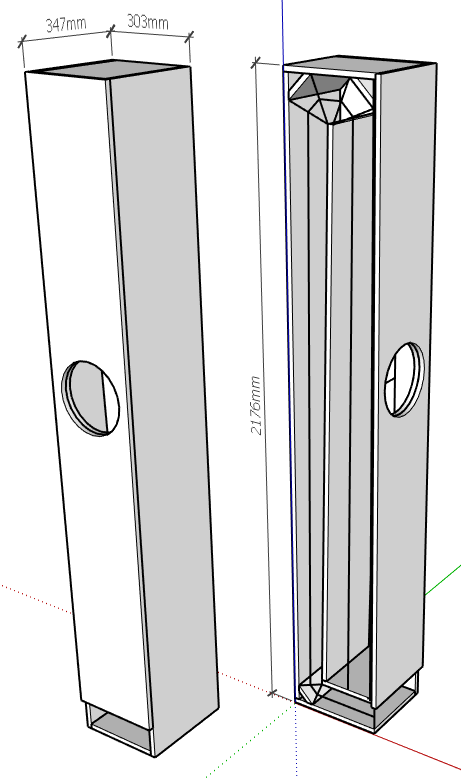
It is going to be huge 😀
2,17 m tall. The TL length is 4,32 m. Looking forward to feel the 15 Hz.
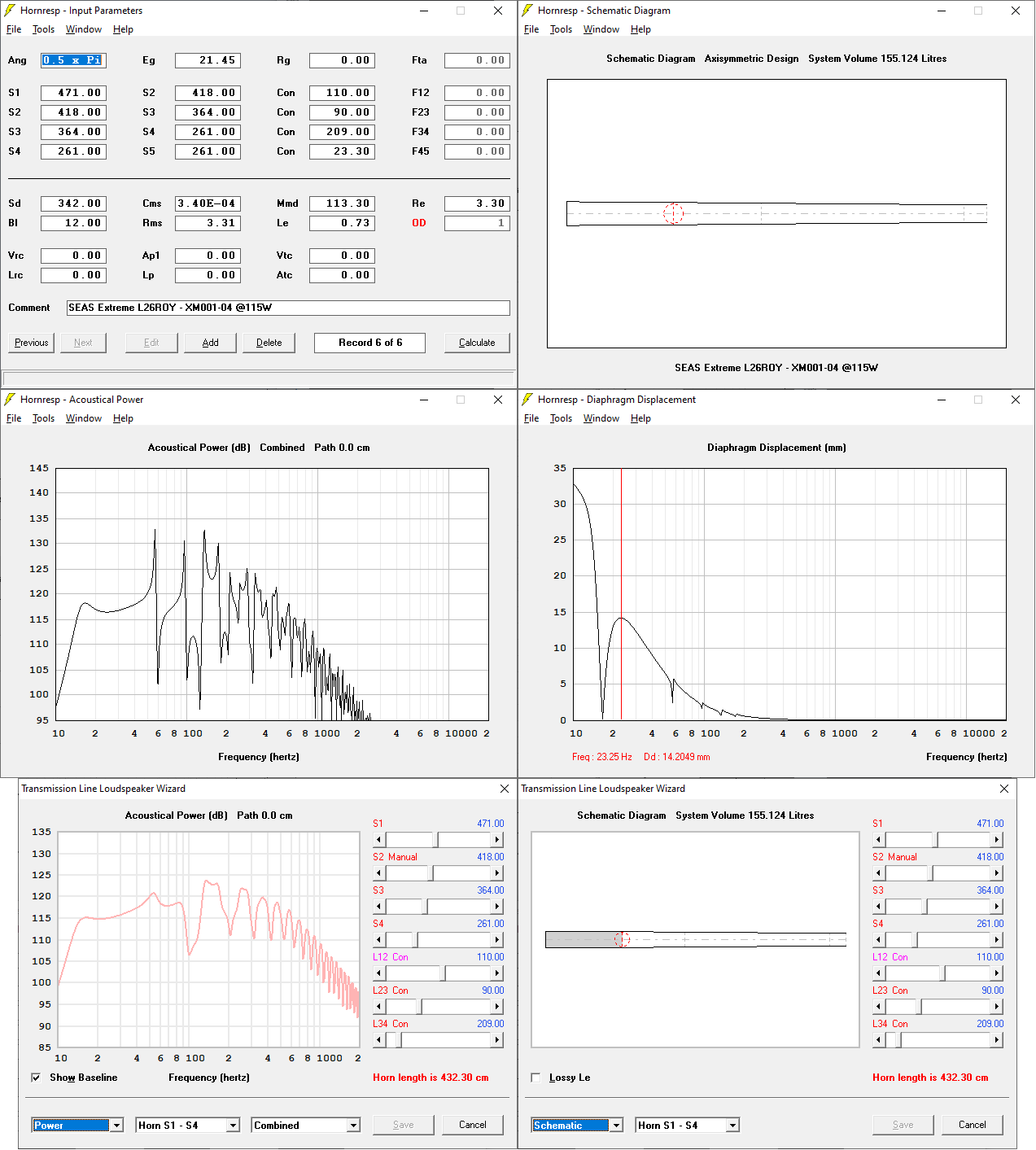
I just ordered my Seas L26ROY. Thanx again GM.
Luckily I had some time today and was able to buy MDF (with some cuts) before the shops closed. Too bad the 22 mm was sold out, but I think 18 mm is fine too. The front side will have an double layer to add some stiffness to mount the driver.
My design was not final, but I think this will work fine.
It is going to be huge 😀
2,17 m tall. The TL length is 4,32 m. Looking forward to feel the 15 Hz.
I just ordered my Seas L26ROY. Thanx again GM.
Attachments
I'd argue the Seas is in a different league to the Dayton, if your goal is sound quality. I believe the driver is essentially the same bass driver as used in Vivid Audio Giya floorstander speakers, which cost 10's of thousands of euros.
Looking forward to seeing your build, very interested in this.
Looking forward to seeing your build, very interested in this.
…images...
You are putting an html link into the image URL, you need to put an image link.
I have fixed at least 2 posts so far. Since the site you link to does not let you directly link please attach the image sto your post.
dave

diyAudio moderation team.
1st impression is that the line is too long and the cross-section not large enuff.
One starts with a set of candidate drivers, and then model the line. Since you have not used in damping in the model, the response is somewhat harde rto interpret, but the way the response roll-off tends to back up my initial impression.
dave
Needs a ‘path’ length equivalent to the offset driver location essentially. 100 cm will be an entirely different harmonic landscape from 60 hz on up😀
Driver location does not impact line length. Only the structure of the generated quarter-wave resonances.
dave
dave
Thanx again GM.
You're welcome!
When using HR, please attach the file for us to install.
Desired XO point/slope?
GM
Last edited:
I'd argue the Seas is in a different league to the Dayton, if your goal is sound quality. I believe the driver is essentially the same bass driver as used in Vivid Audio Giya floorstander speakers, which cost 10's of thousands of euros.
Looking forward to seeing your build, very interested in this.
Wow, those speakers are freaky and awesome too! Thanks Mart.
I already made my choice and ordered the Seas. Still hard to believe these drivers are almost same price; at least over here in the Netherlands.
You are putting an html link into the image URL, you need to put an image link.
I have fixed at least 2 posts so far. Since the site you link to does not let you directly link please attach the image sto your post.
dave
diyAudio moderation team.
Thanks a lot, Dave. Will have a look at that.
1st impression is that the line is too long and the cross-section not large enuff.
One starts with a set of candidate drivers, and then model the line. Since you have not used in damping in the model, the response is somewhat harde rto interpret, but the way the response roll-off tends to back up my initial impression.
dave
Hey Dave, thanks for helping me.
I played a while with HR. Lots of variation in length, cross-section and taper too. This is simply the best result I got. I also figured out that a wider pipe increases the displacement, without any advantages in range or SPL.
I tried both drivers in this TL (and in fact some other drivers too). Not much of a difference in result.
In fact I did add damping and tried many configurations. Best result in HR is to just fill the bottom.
Needs a ‘path’ length equivalent to the offset driver location essentially. 100 cm will be an entirely different harmonic landscape from 60 hz on up😀
Hey Booger, I played width the offset too. It is around 1/4 of the TL. It just gave me best results.
I am not worried about the landscape above 60 Hz. It feels like a fine Xover point with my main speakers. And if not: than that will be my next project 😀
You're welcome!
When using HR, please attach the file for us to install.
Desired XO point/slope?
GM
Hey GM,
Never exported a file. Is it like this?
Attachments
Hey Booger, I played width the offset too. It is around 1/4 of the TL. It just gave me best results.
I am not worried about the landscape above 60 Hz. It feels like a fine Xover point with my main speakers. And if not: than that will be my next project 😀
‘Path’ as in direct radiator’ vs vent center to center. extends the acoustic length traveled between the two to reveal the actual sound at 1meter if split as an isosceles triangle so to speak.
‘Acoustical power’
Tools
‘Ouput’
Combined
‘Path’ ~110cm, not 0.0 cm youll see 🙂
- Home
- Loudspeakers
- Subwoofers
- Which 10" driver for 4m TL?
